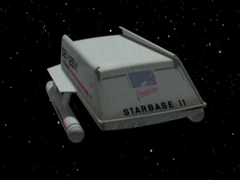The Class F light shuttlecraft was a class of Armed light shuttlecraft operated by the Galactic Republic prior to and during the Clone Wars. Although by 22 BBY it was hopelessly outdated in terms of speed and passenger capacity, even after the introduction of the Class G, it was still used as a robust, easy to maintain light transport.
History[]
The Class F type was introduced in in 27 BBY, serving as a replacement for the worn down classes B and E. By the time of the Separatist Crisis, they served prominently aboard Republic space stations and starships, although it was superceded by the Nu class attack shuttle
The Class F would be used until the end of the Clone Wars, when there were more suitable models like the Nu, Class G, and Lambda classes. However, the Rebel Alliance was known to field them as transports, and used them extensively during their evacuation from Hoth.
Technical Specifications[]
The class F shuttle was equipped with engines that ran on a bulk fuel, stored in tanks and fed through lines into the engine assembly. This fuel mixture was of a particular composition, but the shuttle could be refueled from other energy sources by a sophisticated conversion process performed by an experienced engineer. In order to start the engines, the ship's battery system would provide an energy charge for ignition. Without sufficient energy, the battery would be unable to start the engine. The fuel carried aboard a class F shuttle was sufficient for a period of time at hyperspce in deep space, although the craft was limited in range by fuel supply issues. A shuttle on a long trip might not have sufficient fuel to cross the distances of a starship, necessitating the calculation of return-trip fuel, so that the shuttle does not become stranded in space or travel beyond its capacity to maintain life support for crewmembers.
